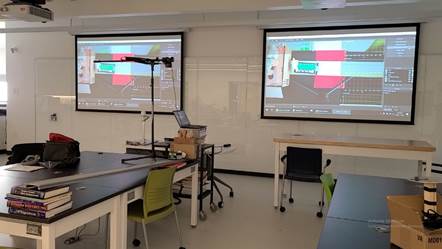Overview
This demonstration aims to build physical intuition about:
⚫ conservation of energy,
⚫ (de)acceleration and,
⚫ collisions.
It has an additional goal to show how physics concepts influence the design of objects in our world.
It does this by using different household materials as bumpers and/or crumple zones in front of a science cart.
The acceleration is measured using a cell phone strapped to the cart running some free software (PhyPhox).
Intended Audience
This demonstration will be best suited for physics 12 (aka grade 12 physics) students and higher, but I think it can be made to be interesting and accessible to physics 11 students. Physics 11 students will have studied kinetic energy and the concept of conservation of energy. They may not completely understand collisions, but their intuition about how things work will be a good primer for when they will learn it in physics 12. The physics 12 students will be more familiar with collisions and will have studied the conservation of energy in more depth.Photos


Setup
We will be attaching different materials to the front of a science cart, letting them roll down an inclined plane, and measuring peak acceleration
Materials
⚫ 1x Pasco Aluminum Dynamics Track (2 meters) (any track will do)
⚫ 1x Pasco Aluminum Collision cart (AKA a Collision Cart)
⚫ Any means by which to set the track at an angle (a stack of books, etc.)
⚫ Something to have the carts crash into (I used several bricks because it must be sturdy)
⚫ Smart phone (iPhone/android) with the PhyPhox.org app installed (see appendix a)
⚫ Phone case (not strictly required, but recommended)
⚫ Painters tape (to attach the phone to the cart)
⚫ Scotch tape (to attach the bumpers to the cart)
⚫ Bumper materials:
o Tin foil
o Bubble wrap
o Packing Styrofoam, any varieties you can find
o Cardboard tubes
o Your own ideas
Pre-demo
Setup
1. Create the crumple zone bumpers and test that they can be securely attached to the Collision Cart: (see the example: Tin foil cone crumple )
a. At least 2 of each type, maybe you can make some backups, just in case they fail;(see Figure 9. Example of a Tin foil cone crumple zone taped to the Collision Cart for an example)

The best way to make a consistent tin foil cone is to make a cone out of rigid cardstock, then use that as a form. Wrap the tinfoil around the cardstock cone and tape it together.
2. Install the PhyPhox.org app onto your phone
a. Install the science of car crashes custom Phyphox lab (use this QR code or download the code directly into the phyphox editor yourself)

3. Raise the track to an appropriate angle such that the Collision Cart and phone will not be damaged, a few degrees will be fine, you want to be able to see the impact happen (see Figure 11 Collision Cart on the track at an angle)

4. Place some firm stable objects at the base, a stack of books, or the stopper provided by the track system. (I ended up using 9 bricks I found because textbooks were not heavy enough)

5. Attach your phone, screen side out to the Collision Cart with tape or a clamp. I ended up using some aluminum and cutting/bending it to make a cradle for my phone to make it more secure.
This aluminum bit on top of the cart was bolted, and then a bit of cardboard was added to make the surface flat for the phone


6. Optional, when I did it I had a camera viewing from above that could let the students see the crash on the bigger screen, but you can just have them gather around

Doing the Demo
1. Enable the PhyPhox experiment, but do not hit start yet.
2. Set Phyphox to Allow remote access: this will enable a webpage on the subnet of your Wi-Fi network. (i.e., something like 192.168.0.15:8080) navigate to that website in your browser on the computer, and also in the browser component in OBS if you are using it
3. Attach the custom crumple zone to the front of the car and set it on the track, get an assistant to hold it in place with a pencil
4. Securely attach the phone to the cart via a clamp, or tape (The phone must be securely attached to the Collision Cart, or its movement will interfere with the acceleration readings!)
a. I actually found that painters tape worked pretty well, and it does not leave gunk on the phone
5. Hit the play/(start) button on the Phyphox app, (you can do this from the webpage, or directly on the phone, whichever is easier) usually the phone will have tape on it, so
6. After a second or so, release the car to allow it to travel down ramp
7. After the colision stop the data collecting on phyphox and review the reported values
